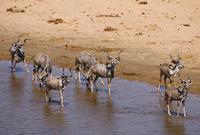Landscape of fear and resource heterongeneity - ANR FEAR
Last update: 13 March 2013
Dates: 2009-2012
Summary
Understanding patterns of species diversity and species coexistence has been a long standing challenge in ecological research, and has received renewed attention with increasing concerns about biodiversity conservation. African savannas are terrestrial systems in which remains the world's highest diversity of large carnivore and herbivore species, making them valuable ecosystems to study the relative importance of bottom-up and top-down processes in shaping large vertebrate communities. If the factors underlying the abundance of African savanna ungulate communities are well understood and explained by primary production, attempts to explain ungulate species coexistence have so far been only moderately satisfying. A promising hypothesis based on the interaction between spatial environmental heterogeneity and different landscape perception, movement and nutritional requirement of different body sized herbivores has been proposed. However, experimental evidence has failed to support this hypothesis. Following the concept of the ‘Ecology of Fear’, recent studies also argue that ungulate behaviour may be primarily affected by the risk of predation. Body size of large herbivores determines their susceptibility to predators, and in this project we hypothesize that integrating indirect effects of predation will help explain the distribution, foraging behaviour, and ultimately the coexistence of different body size sympatric ungulates, as it has been suggested in other systems (e.g. gerbils).
Here we propose a unique approach based on the simultaneous monitoring of four sympatric herbivores of increasing body size and their main three predators. We focus on highly diverse savanna ungulate communities for which comprehensive studies are missing, but also represent major conservation challenges. We expect that testing for the effect of the landscape fear on the use of spatial resource heterogeneity by sympatric herbivores will originally add to the scientific debate by quantifying the interaction between predation and competition as a mechanism of coexistence between large mammal species, which remains poorly investigated.
Last update: 13 March 2013


